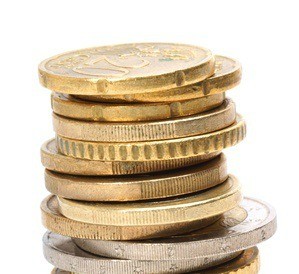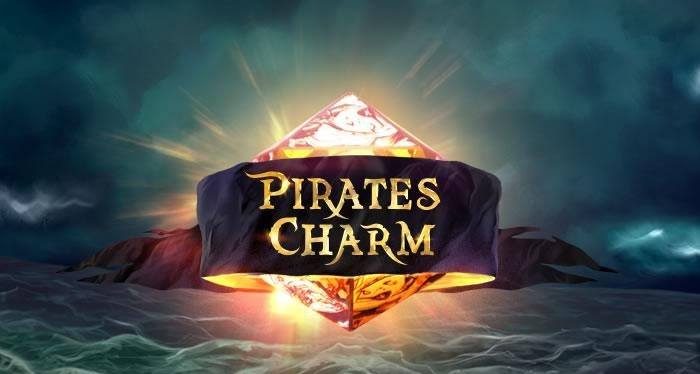Baccarat (or Punto Banco) is the most played casino table game in many parts of the world. Baccarat is incredibly popular in many Asian countries.
There are mainly Baccarat tables in Macau casinos, and many of the serious high rollers in Las Vegas play Baccarat, with bets in the hundreds of thousands of dollars.
Bizarre but true!
This game is also played often in the Live Casino. Evolution Gaming leads the pack with some fantastic variations on the traditional Baccarat, such as Lightning Baccarat, Speed Baccarat, Baccarat Squeeze and Tiger Dragon Baccarat.
Even though Baccarat is easy to play, there are a few game rules you should familiarize yourself with before you play. And yes, there are also some tips and tricks that are useful to know.
Baccarat (Punto Banco) – Explanation of game rules and bets of this popular table game
Below I’ll tell you everything you want to know about:
- What bets (bets) are there, and what are the payouts of these bets?
- The rules of the game – when are cards drawn or not
- The bets with the highest payout percentages (lowest house edge)
- Side bets (or “sucker bets”) and why you should always avoid these
I end this article with many examples to make it all a bit easier to digest.

Bet on the Player, the Banker, or the Tie bet
Baccarat is not that complicated. All you need to do is bet on who you think will win the next Baccarat game.
You bet on:
- A win of the Player (Punto)
- A win of the Banker (Banco or Bank)
- A Tie (Draw)
I must say that it’s all a bit confusing regarding naming.
You, as a player, might think that you are the “Player.”
And it’s not strange to think that the dealer is the “Banker.” But none of this is true!
The “Player” and the “Banker” are two parties (outcomes) on which you can bet, and that is independent of the player (e.g. yourself) or the dealer or the banker (who represents the casino and organizes the game).
Yes, you can also compare Baccarat’s “Player” and “Banker” to Roulette’s “Black” and “Red.”
Anyway, after you’ve placed your bet, the game starts. Both the Player (Punto) and the Banker (Banco) get 2 cards.
Who wins? The Banker or the Player?
Whoever is closest to a card value of 9 wins. The result is a draw (or a Tie) if both parties have the same card value.
The card value is the total card value (points total) of the 2 or 3 cards that both parties get.
The Player and the Banker might get a 3rd card. It’s dependent on the total card value of the first 2 cards of the Player and the Banker.
The dealer takes care of all of this and obeys specific preset rules. Unlike Blackjack, it’s not up to you to decide if a 3rd card is drawn or not.
Baccarat payouts
The payouts are as follows:
If the Player wins:
– If you have bet on the Player, you get paid out a total of 2x the bet (therefore, your win is 1x)
– If you placed a bet on the Banker or a Draw, you lose the entire bet.
If the Banker wins:
– If you have a bet on the Banker, the total amount paid is 1.95x the bet (the profit is 0.95x the bet).
– If you placed a bet on the Player or a Draw, you lose the entire bet.
Yes, you can see that if the Banker wins, your winnings are (only) 95% of the bet because the online casinos withhold a 5% commission. There is a reason for this: the Banker has better odds of winning than the Player
If it is a Draw (or Tie):
– If you placed a bet on a Draw, you get 9x the bet paid out (the winnings are 8x the bet). Some casinos are more generous and payout 10x the bet.
– If you have bet on the Player or Banker, you don’t lose, but you don’t win either. Your bet stays intact for the next round.
Below is a picture with a summary.
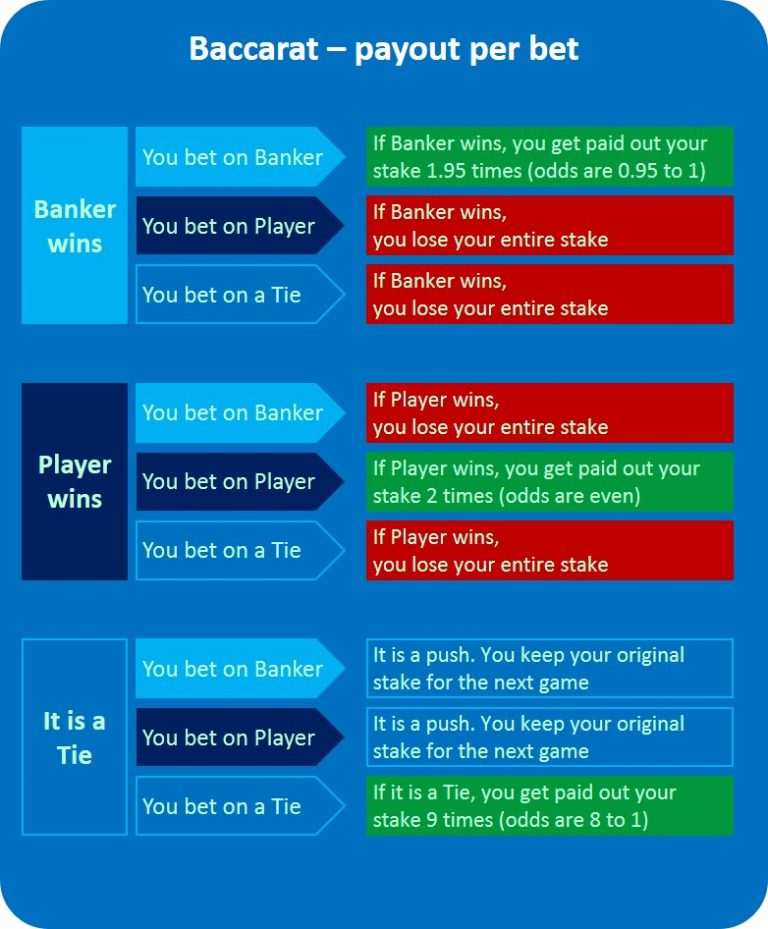
The rules of the game
To understand the rules, you need answers to the following two questions:
- How do you determine the total card value of the Banker or the Player?
- When does the Banker or the Player get a 3rd card?
Let me tell you all about it right now!
Determination of the total card value
Both the Player (Punto) and the Banker (Banco) get 2 cards to start with.
To avoid doubt, neither you nor the dealer is the “Player” or the “Banker.”
These are only two possible outcomes of Baccarat on which you can bet.
As soon as both (the Player and the Banker) get the 2 cards, the total value is determined.
It’s done for both the Player and the Banker).
- The A is worth 1 point.
- The K, Q, J, and 10 are worth 0 points.
- The other playing cards (2 to 9) have the value that is on the card (so 2 to 9).
If the total value has one digit (0 to 9), then that’s the final value. If the total value has two digits (10 or more), the left number is removed, leaving a single digit.
Some examples:
- 6 and K: The total value of this hand is 6 + 0 = 6.
- 6 and 7: The total value of this hand is 6 + 7 = 13. Because it is a 2-digit number, the 1 is removed. The total value is 3.
- 6 and A: The total value of this hand is 6 + 1 = 7.
- 8 and 2: The total value of this hand is 8 + 2 = 10. Because it is a 2-digit number, the 1 is removed. The value becomes 0.
- 10 and Q: The total value of this hand is 0 + 0 = 0.
When does the Banker or the Player get a 3rd card?
It is decided according to the fixed Baccarat rules.
The Player always gets a 3rd card if the Player’s total card value (of the first 2 cards) is 0 to 5 points.
Whether the Banker gets the 3rd card or not depends on the total card value of both the Banker and the Player.
I explain the rules (which are indeed pretty complicated) in detail below. It’s not required to know these rules by heart.
Yes, the dealer of the casino does need to know these rules. After all, it’s the dealer who does the work for you. He or she will apply the prescribed rules. If you’re curious and want to follow the gameplay, it helps to understand these. Besides, you’ll enjoy the game more when you do.
Unlike Blackjack, neither the dealer nor you decide if the Banker or the Player gets the 3rd card (or not). You have no influence. Specific rules are obeyed: nothing more and nothing less.
What is the 3rd card rule for the Player in Baccarat?
The game ends if the Player and/or the Banker get a total of 8 or 9 points (with the first 2 cards). Therefore, no 3rd card is drawn for the Player or the Banker. It, by the way, is called a “natural.”
If the Player gets a total card value of 6 or 7, he must stand. He gets a 3rd card if the total card value is 5 points or less.
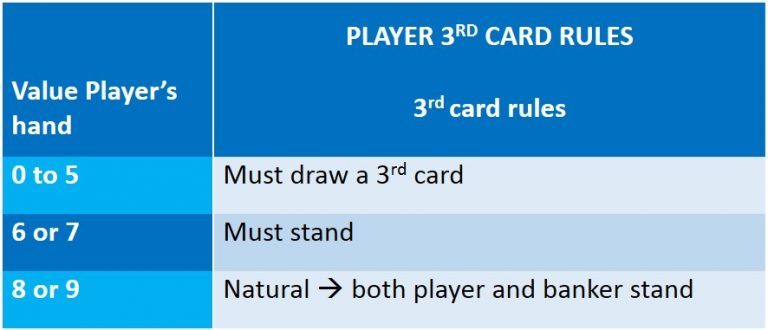
What is the 3rd card rule for the Banker in Baccarat?
If the Player does not get a 3rd card, and the Banker has in total:
- 0 to 5 points: then the Banker gets a 3rd card.
6 or 7 points: then the Banker does not get a 3rd card (must stand)
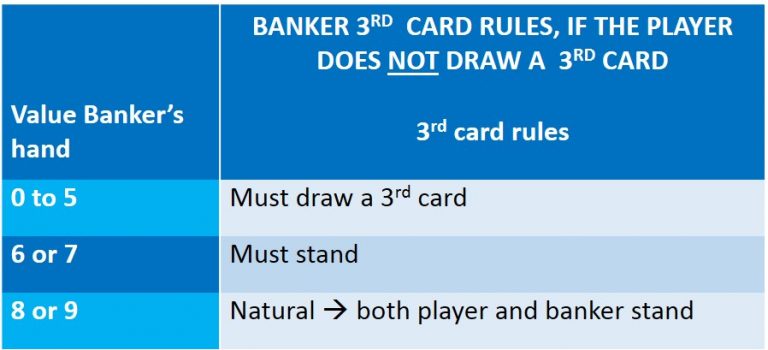
If the Player does get a 3rd card, and the Banker has a total:
- 0 to 2 points: then the Banker gets a 3rd card (must draw), regardless of what the 3rd card of the Player is.
- 3 points: then the Banker gets a 3rd card unless the Player’s 3rd card is an 8.
- 4 points: the Banker receives a 3rd card unless the 3rd card of the Player is a 0, 1, 8 or 9.
- 5 points: the Banker receives a 3rd card if the 3rd card of the Player is a 4, 5, 6 or 7.
- 6 points: the Banker receives a 3rd card if the Player’s 3rd card is a 6 or 7.
7 points: the Banker does not receive a 3rd card (must stand).
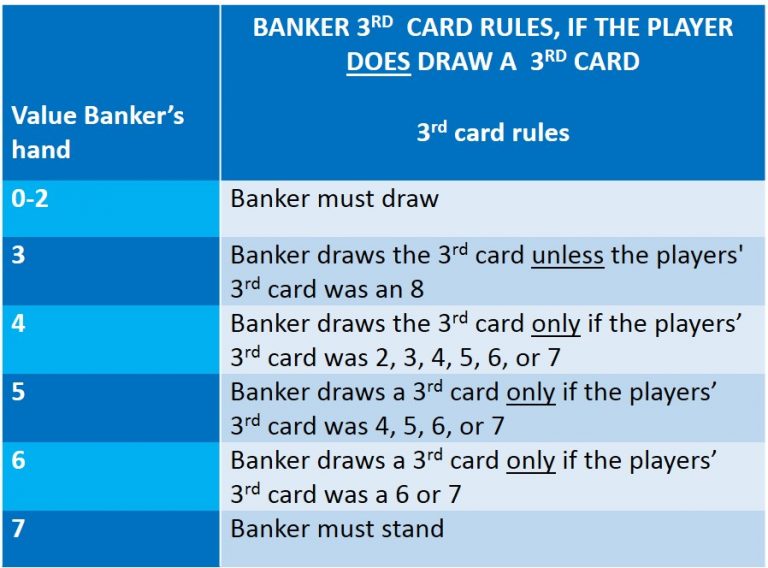
The illustration below shows how the Player’s 3rd card rule and the 3rd card rule of the Banker work.
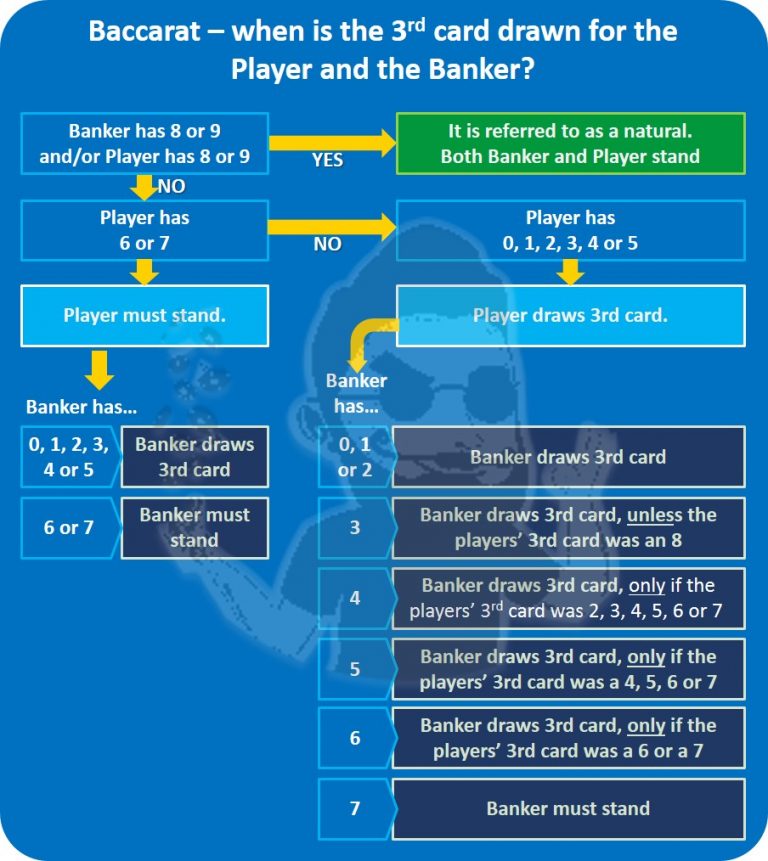
It may be a bit overwhelming at first, but you’ll get used to it once you have seen it a few times.
You see some further examples at the bottom of this article.
What is the house edge?
The chance that the Banker wins is 45.86%. The chance that the Player wins is 44.62%. The probability of a Draw is 9.51%.
It is best to bet on the Banker and bet that the Banker wins the game. Even with the 5% commission, the payout percentage on this bet is the highest: 98.94%. It equates to a house edge of only 1.06%.
Yes, it’s one of the most attractive bets in an online casino and explains why the Baccarat game is so popular!
If you bet on the Player, and if the Player wins, you get a higher payout (you don’t have to pay 5% commission), but the odds of winning are slightly smaller. The payout percentage is 98.76% (house advantage is 1.24%), which is still highly attractive.
Besides, the differences are tiny. Both bets are still much more attractive (with better house edges) than many other table games, such as Roulette (house advantage is 2.70% with European Roulette).
Having said this, it’s better to ignore the Draw bet (Tie bet). Yes, the payout (if you’re right) is much higher (9x the bet), but the odds are much smaller.
The house edge on the Draw bet is as much as 14.36%. That boils down to a payout percentage of a meager 85.64%.
If the payout is 10x the bet instead of 9x the bet (which some online casinos are willing to offer), you get a much better payout percentage of 95.16%. It may be interesting, as the wins are more substantial.
The calculations are in the table below.
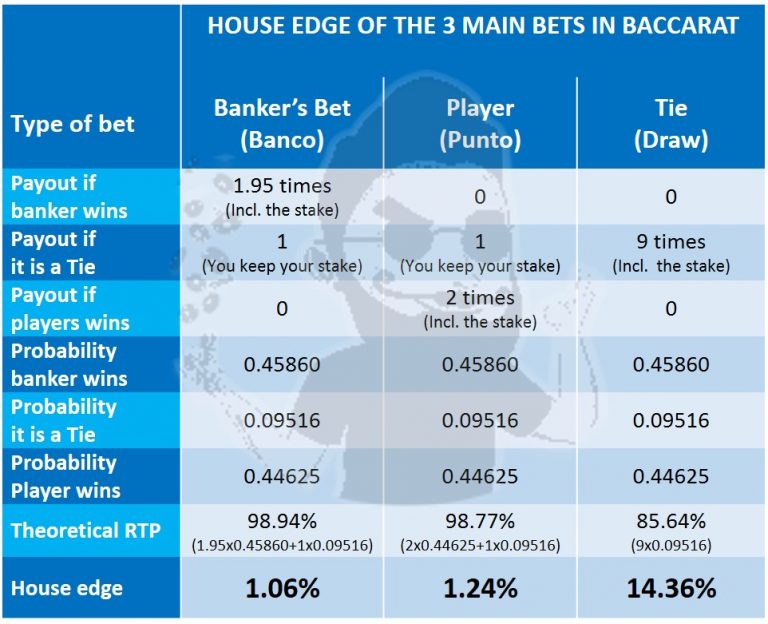
As you can see in the table, the odds are based on an 8-deck Baccarat game with 52 cards per deck, which is most common at most online and land casinos.
The house edge figures are marginally different if the game is played with fewer decks (1 or 6).
Are side bets worthwhile at Baccarat?
Up to now, I’ve only elaborated on the regular (main) bets. Believe it or not, there there are dozens of other bets you can place.
These are called side bets. The problem is that these bets have a much lower payout percentage, which are also called “sucker bets.”
These bets are more attractive for casinos than for you.
Most of these side bets sound attractive, though, as these usually have a much more substantial payout. But don’t get trapped into these sucker bets. The odds of winning are small, and the payout percentages are low.
For many side bets, you look at, for example, the total card value of the Banker and Player together.
You look at the difference or colour of the cards or a combination thereof for other side bets.
For some bets, the wins can be as high as over 100x the bet, but, again, the odds are very, but very small.
The payout rates for these side bets are usually around 90% (house edge of 10%), but some even have a lower payout rate. These bets are called “sucker bets” for a reason. In summary, stay away from these!
Some real card examples of Baccarat in action
As promised, I end my article with some more examples.
Examples, where neither the Player nor the Banker gets a 3rd card

Examples, where only the Banker gets a 3rd card
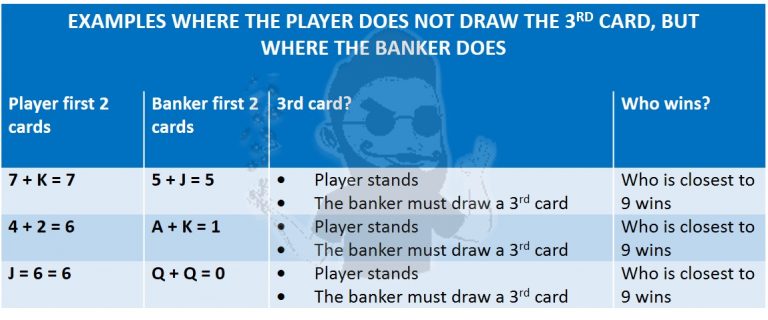
Examples, where the Player gets the 3rd card and where the Banker might get a 3rd card. The latter depends on the value of the 3rd card of the Player)
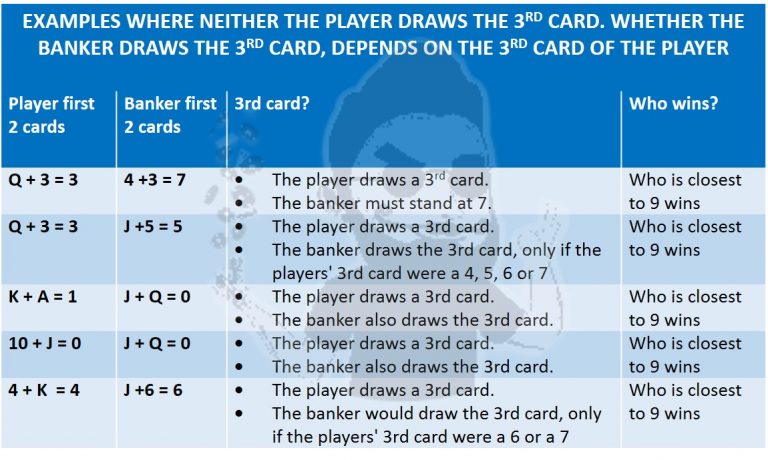
Play online Baccarat at these online casinos
If you are looking for great fun and want to enjoy Baccarat, you can check out the online casinos in our list below.
These online casinos offer you the chance to play real money casino games or play with practice money.
Please check out our popular page, where we break down the best and worst Baccarat betting strategies.







